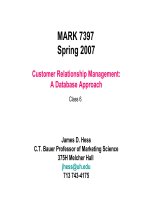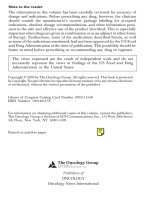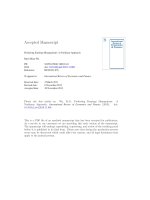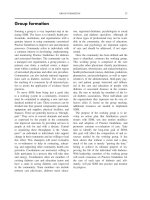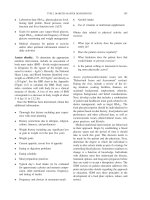Predicting earnings management a nonlinear approach
Bạn đang xem bản rút gọn của tài liệu. Xem và tải ngay bản đầy đủ của tài liệu tại đây (1.03 MB, 78 trang )
Predicting Earnings Management: A Nonlinear Approach
Ruei-Shian Wu
PII: S1059-0560(13)00116-0
DOI: doi: 10.1016/j.iref.2013.11.001
Reference: REVECO 876
To appear in: International Review of Economics and Finance
Received date: 3 March 2011
Revised date: 6 November 2013
Accepted date: 10 November 2013
Please cite this article as: Wu, R S., Predicting Earnings Management: A
Nonlinear Approach, International Review of Economics and Finance (2013), doi:
10.1016/j.iref.2013.11.001
This is a PDF file of an unedited manuscript that has been accepted for publication.
As a service to our customers we are providing this early version of the manuscript.
The manuscript will undergo copyediting, typesetting, and review of the resulting proof
before it is published in its final form. Please note that during the production process
errors may be discovered which could affect the content, and all legal disclaimers that
apply to the journal pertain.
ACCEPTED MANUSCRIPT
ACCEPTED MANUSCRIPT
1
Predicting Earnings Management: A Nonlinear Approach
Ruei-Shian Wu
Yuan Ze University
College of Management
135 Yuan-Tung Road
Chung-Li 32003, Taiwan
Phone: +886-3-463-8800 ext.2195
Fax: +886-3-463-3824
E-mail:
ACCEPTED MANUSCRIPT
ACCEPTED MANUSCRIPT
2
1. Introduction
Accrual accounting, with all its strength and weaknesses, occupies the dominant position in
external financial reporting and is, therefore, the primary means by which the capital market
measures firm value. To reflect positively on economic activity during a given period,
accrual accounting temporally disconnects the recognition of revenues and expenses from
their associated cash flows. The result is earnings and balance sheet measures with prime
roles in performance measurement, valuation, and contracting. However, the judgments
required within accrual accounting offer managers opportunities to mislead stakeholders
and alter contractual results to their benefit. Previous research has examined earnings
management via consideration of specific accruals, total accruals, and the decomposition of
total accruals to their abnormal and discretionary components. Normal accruals relate to
changes in economic circumstances, such as changes in sales and fixed assets. Accruals
other than normal accruals are perceived as discretionary. That is, discretionary accruals are
considered those accruals that are prone to manipulation (Healy, 1985). The literature has
widely investigated the association between discretionary accruals and earnings
management.
Researchers have commonly employed the Jones (1991) model and the modified Jones
model (Dechow, Sloan, & Sweeney, 1995) to estimate the discretionary component of
ACCEPTED MANUSCRIPT
ACCEPTED MANUSCRIPT
3
accruals. Using simulation studies, Dechow et al. and Kothari, Leone, and Wasley (2005)
show that these models often provide reasonable estimates for detecting earnings
management. However, they point out that the models present problems for firms
experiencing extreme levels of performance. Such problems may reflect measurement
errors. Thus, to improve the estimation quality, accrual models must consider the context to
which earnings management is hypothesized.
In addition to the measurement error inherent in discretionary accruals models (e.g.,
McNichols & Wilson, 1998), coefficient bias can also stem from using balance sheet data
rather than cash flow statement data (Hribar & Collins, 2002). Thus, possible improvements
to the Jones model and the modified Jones model include adding cash from operations,
earnings, and return on assets (DeAngelo, DeAngelo, & Skinner, 1994; Jeter & Shivakumar,
1999; Kothari et al., 2005; Rees, Gill & Gore, 1996), controlling for firm performance
(Holthausen et al., 1995; Kothari et al., 2005), and using cash flow statement data to check
the robustness (Hribar & Collins, 2002).
In addition, researchers have recently begun to question the assumption that the
accrual-generating process in the existing empirical cross-sectional accrual models is
inherently homogeneous. That is, cross-sectional accrual models such as the Jones model
and the modified Jones model implicitly assume that firms within the same industry in a
given year have a homogeneous accrual-generating process. Dopuch, Seethamraju,
ACCEPTED MANUSCRIPT
ACCEPTED MANUSCRIPT
4
Mashruwala, and Zach (2007) argue that the assumption of a uniform accrual-generating
process is violated in industries. Because the accrual-generating process affects the
measurement of the accrual models’ coefficients, whether a substantial variation exists in
the estimated coefficients of each explanatory variable across the different levels in accrual
models is important.
Because firms with extreme performance are more likely to engage in earnings
management (Guay, Kothari, & Watts, 1996), the conventional linear accrual models that do
not consider the asymmetric influences of performance variables may lead to biased
inferences. Previous studies (Ball & Shivakumar, 2006; Kothari et al., 2005) have attempted
to solve the nonlinear relation between accruals and performance proxies. Kothari et al.’s
performance-matched accrual model, which uses return on assets (ROA) as a proxy for
performance, does not assume a linear relation between accruals and performance. Although
Kothari et al.’s nonlinear model is less misspecified than the Jones model and the modified
Jones model, the model still suffers overrejection or underrejection when adopting
earnings-to-price ratio, firm size, and operating cash flow as the performance proxy.
Moreover, by matching each firm-year observation with another firm in the same industry
and year and then calculating the differences for the Jones and modified Jones discretionary
accruals with the closest ROA, the model assumes that firms in the same industry with
similar ROA have comparable discretionary accruals. Therefore, if either firm numbers in
ACCEPTED MANUSCRIPT
ACCEPTED MANUSCRIPT
5
an industry are small or the variation in ROA in an industry is large, a measurement error is
generated. In addition, if the hypothesis of earnings management is applied to a firm with an
extreme earnings-to-price ratio, firm size, or operating cash flow, Kothari et al.’s
ROA-matched discretionary accrual model leads to misspecified tests.
Although Ball and Shivakumar (2006) adopted a piecewise linear regression model to
address the impact of losses on accruals, their study does not focus on the coefficient bias
resulting from the nonlinear relation between accruals and performance proxies other than
economic losses. I examine the variation of coefficients across performance quartiles and
the effect of the nonlinear relation between accruals and performance. Because the
performance-matched accrual model exhibits these limitations, I adopt a three-breakpoint
piecewise linear regression to accommodate the possibility of a nonlinear relation between
accruals and performance proxies.
A number of studies show that the Jones model suffers an omitted variable problem
(DeAngelo et al., 1994; Dechow et al., 1995; Jeter & Shivakumar, 1999; Kothari et al., 2005;
Rees et al., 1996). However, commonly used accrual models do not include cost- or
expense-related variables. According to a U.S. Government Accountability Office (GAO;
2007) report, revenue recognition issues account for approximately 38 percent of
restatements between January 1997 and June 2002 and are the main reason for restatements
during this period. Nevertheless, cost- or expense-related issues account for more than
ACCEPTED MANUSCRIPT
ACCEPTED MANUSCRIPT
6
one-third of the restatements from July 2002 through September 2005 and surpass revenue
recognition as the most frequently identified cause of restatements in the period after the
passage of the Sarbanes–Oxley Act (SOX). Therefore, I further take cost- and
expense-related variables into account.
To compare the ability of conventional linear accrual models and my nonlinear
expense-related accrual model to discriminate between firms engaging in earnings
management and firms not engaging in earnings management, I use GAO (2002, 2006,
2007) reports to identify firms with a financial restatement to proxy for firms with earnings
management. The control group is composed of firms in the same industries but not in the
GAO reports and without a financial restatement record in Compustat.
The results suggest that the relation between accruals and performance proxies is
nonlinear. The findings show that the nonlinear expense-related accrual model is
well-specified and enhances the reliability of inferences in earnings management issues. My
objective is not to develop a cure-all accruals model, in terms of either accounting theory or
empirical fit with accruals data. Rather, I demonstrate a specification improvement in
nonlinear accrual models by incorporating the asymmetric influence of performance levels
associated with specific earnings management issues (i.e., event-specific studies of earnings
management). In addition, I show the robust results after the passage of SOX.
The remainder of the paper is organized as follows. Section 2 presents the variation of
ACCEPTED MANUSCRIPT
ACCEPTED MANUSCRIPT
7
coefficients across performance partitions. Section 3 develops the models with
consideration for the nonlinear relation between accruals and performance proxies. Section
4 describes the data selection procedure, and Section 5 outlines the results. Section 6
presents my conclusions.
2. Coefficient bias
Prior studies estimate the accrual models using time-series (e.g., Dechow et al., 1995; Jones,
1991), cross-sectional (e.g., Cheng, Davidson, & Leung, 2011; Kothari et al., 2005; Shu &
Chiang, 2013), and panel (e.g., Ball & Shivakumar, 2006) regressions. Using samples to
estimate coefficients in conventional linear accrual models assumes the slope coefficients
are constant within the sample, that is, observations in the sample have a uniform
accrual-generating process (Bartov et al., 2000). If an accrual model estimates the
coefficient within the same industry, it assumes that firms in the same industry have similar
accrual-generating processes. However, the uniform accrual-generating process assumption
may not be proper for firms with extreme performance within the industry, leading to biased
discretionary accrual estimates. In the following discussion, I review the properties of
coefficients in linear regressions and then inspect whether the coefficients are equal across
firms in different performance quartiles.
ACCEPTED MANUSCRIPT
ACCEPTED MANUSCRIPT
8
2.1. Properties of coefficient in linear accrual models
In conventional linear accrual models the coefficients are estimated under the uniform
accrual-generating process. This study relaxes this assumption for firms within the same
industry category in a given year but with different levels of performance. To assess
coefficient bias in relation to performance, I consider coefficients for subsamples based on
performance. Let B be the pooled sample coefficient matrix, x be the independent variable
vector, and y be the dependent variable matrix. I divide the pooled sample into m
subsamples; therefore, the subsample’s independent and dependent matrices are
] [
1
m
xxx
and
] [
1
m
yyy
, respectively. The vector of coefficient estimates is derived
as follows:
yxxx
1
][
] ][ [][
11
1
mm
yyxxxx
) (][
11
1
mm
yxyxxx
mm
yxxxyxxx
1
11
1
][ ][
mm
yxxxyxxx
1
11
1
][ ][
mmmmmm
yxxxxxxxyxxxxxxx
11
11
1
1111
1
]][[][ ]][[][
mm
11
, (1)
where I is the identity matrix,
][][
1
iii
xxxx
,
iiiii
yxxx
1
][
,
] [
1 m
mi , ,1
is
ACCEPTED MANUSCRIPT
ACCEPTED MANUSCRIPT
9
a matrix of the ratios of the sum of subsample values squared to the sum of full sample
values squared, and
] [
1
m
mi , ,1
is the coefficient matrix of subsample
i
s.
For equation (1), the pooled sample coefficient is calculated by subsample coefficients
with the weights of a function of subsample independent variables. The linear accrual
models directly estimate the coefficient of B and do not take into account the corresponding
coefficient matrix of subsamples, which are identified by performance levels. If
1
through
m
are not statistically different from B, that is, if the accrual-generating processes
for the subsamples are identical, the conventional linear accrual model will not misestimate
discretionary accruals for subsamples formed based on performance. Otherwise, the
uniform accrual-generating assumption that restricts the vector β equals B and may result
in biased discretionary accruals and false inferences of earnings management. I discuss the
likely biases separately for the upward and downward earnings management.
Case 1: Upward earnings management (discretionary accruals > 0). If the estimated
coefficients overestimate the true coefficients, the discretionary accruals will be
undervalued. Such misspecification results in a rejection rate that is too low and
biased in favor of the null hypothesis. However, if the coefficient matrix
underestimates the true values, the discretionary accruals will be too large. This
misspecification leads to a higher rejection rate.
Case 2: Downward earnings management (discretionary accruals < 0). If the
ACCEPTED MANUSCRIPT
ACCEPTED MANUSCRIPT
10
coefficient matrix overestimates the true coefficients, discretionary accruals will be
undervalued. Large negative discretionary accruals produce a high rejection rate and
are associated with overrejection. Nevertheless, the undervaluation of the coefficient
matrix causes the discretionary accrual to be overvalued and to approach zero from
left; the closer to zero the discretionary accrual is, the harder it is to reject the null
hypothesis. Therefore, if the coefficient matrix is overvalued (undervalued), the null
hypothesis is overrejected (underrejected).
2.2. Relations between accruals and performance
In the conventional linear accrual model, explanatory variables are obtained from financial
statements. Because a number of studies confirm a negative relation between size and
performance (Fama & French, 1992; Lakonishok, Shleifer, & Vishny, 1994, among others),
I recognize size as a performance proxy. Here I consider the relations between accruals and
various performance proxies. If the relations are linear, prior earnings management studies
regarding performance are still reliable (Bartov et al., 2000). Otherwise, the coefficient bias
may lead to misspecified tests and either overrejection or underrejection.
To capture intuitively the relation between accruals and performance proxies, in Figure
1 I plot mean values of accruals scaled by total assets at the beginning of the year across
performance deciles. Specifically, Figures 1.1 to 1.8 plot, respectively, mean accruals across
ACCEPTED MANUSCRIPT
ACCEPTED MANUSCRIPT
11
deciles of (a) change in sales; (b) change in sales less change in accounts receivable; (c)
property, plant, and equipment; (d) the inverse of beginning total assets for the period; (e)
lagged total accruals; (f) return on assets; (g) change in cost of goods sold less change in
inventory; and (h) change in operating cash flow. The average accruals positively correlate
to change in sales, change in sales adjusted by accounts receivable, lagged total accruals,
and return on assets. Not surprisingly, operating cash flow has negative correlation with
average accruals. The relations between average accruals and performance are nonlinear,
except for lagged total accrual.
[FIGURE 1 ABOUT HERE]
3. Discretionary accrual measurement
I replicate the results of prior research by using conventional linear accrual models and
pooled data as the comparison benchmark. I then apply a piecewise linear regression
approach to create the nonlinear Jones model and nonlinear modified Jones model. These
nonlinear models use the same independent variables as the conventional Jones model and
modified Jones model but relax the linearity assumption to allow the effect of each predictor
variable to vary across different predictor quartiles. By comparing the conventional Jones
model with the nonlinear Jones model and the modified Jones model with the nonlinear
modified Jones model, we can observe the influence of nonlinearity in the accrual models.
ACCEPTED MANUSCRIPT
ACCEPTED MANUSCRIPT
12
Next, I consider the nonlinear influence of performance, which is commonly related to
earnings management scenarios of interest. I reproduce Kothari et al.’s (2005)
performance-matched discretionary accruals. Because researchers commonly use the
accruals model to detect earnings management, it can be used as a comparison benchmark.
Finally, I construct my nonlinear accrual model by further considering cost- or
expense-related earnings management, which is omitted in previous accrual models. In my
nonlinear accrual model, I also employ a piecewise linear regression approach to estimate
discretionary accruals.
3.1. Linear accrual models
I employ Kothari et al.’s (2005) adaptation of the Jones and modified Jones accruals models.
Like Kothari et al., I include an intercept term as an additional control for heteroskedasticity
that is not alleviated by using assets as the deflator and to mitigate problems stemming from
an omitted size variable. The resulting Jones and modified Jones models are, respectively,
as follows:
ttt
t
t
PPESales
TA
Ac
)()()
1
(
32
1
10
, (2)
tttt
t
t
PPEARSales
TA
Ac
)()()
1
(
32
1
10
, (3)
where Ac
t
is accruals in year t,
t
Sales
is change in sales, PPE
t
is gross property, plant,
and equipment, and
t
AR
is change in accounts receivable, all scaled by beginning of the
ACCEPTED MANUSCRIPT
ACCEPTED MANUSCRIPT
13
period total assets (TA
t–1
).
3.2. Nonlinear Jones and nonlinear modified Jones models
To address the nonlinearity issue, I first relax the linear assumption in the Jones and
modified Jones models. I employ a three-breakpoint piecewise linear regression to consider
the nonlinear relation among total accruals, change in sales, change in sales adjusted by
change in accounts receivable and property, plant, and equipment. The nonlinear Jones
model is
t
Q
Qi
ittiittiitiitii
tt
t
t
PPEDPSalesDSDPDS
PPESales
TA
Ac
3
1
,,,,
1
])()(1[
)()()
1
(
, (4)
The nonlinear modified Jones model is
t
Q
Qi
ittiitttiitiitii
tt
t
t
PPEDPARSalesDSDPDS
PPESales
TA
Ac
3
1
,,,,
1
])()(2[
)()()
1
(
, (5)
where DS1
i,t
, DS2
i,t
and DP
i,t
are dummy variables that equal 1 if change in sales, change in
sales adjusted by accounts receivable and gross property, plant, and equipment are located
respectively in the quartile i groups (Qi) in year t, and zero otherwise, and
is the error
term.
ACCEPTED MANUSCRIPT
ACCEPTED MANUSCRIPT
14
3.3. Performance-matched accrual model
The performance-matched accrual model proposed by Kothari et al. (2005) is based on the
Jones or modified Jones model with one more step: matching firms on current or annually
lagged return on assets. For the performance-matched discretionary accrual measure for
Firm A, I subtract Firm A’s model-derived discretionary accrual estimate from the estimate
for the firm in the same industry with most closely matched ROA or lagged ROA. Previous
studies also adopt ROA or lagged ROA as an additional independent variable in accrual
models and yield results similar to those found using the previously mentioned
sample-matched approach. To enhance the comparability among various accrual models, I
report the empirical results of the performance-matched model by adopting ROA or lagged
ROA as an additional variable in the regression model. The performance-matched Jones
model on ROA is
tttt
t
t
ROAPPESales
TA
Ac
)()()()
1
(
432
1
10
; (6)
the performance-matched Jones model on lagged ROA is
tttt
t
t
ROAPPESales
TA
Ac
)()()()
1
(
1432
1
10
; (7)
the performance-matched modified Jones model on ROA is
ttttt
t
t
ROAPPEARSales
TA
Ac
)()()()
1
(
432
1
10
; (8)
the performance-matched modified Jones model on lagged ROA is
ttttt
t
t
ROAPPEARSales
TA
Ac
)()()()
1
(
1432
1
10
, (9)
ACCEPTED MANUSCRIPT
ACCEPTED MANUSCRIPT
15
where ROA
t
and ROA
t-1
are return on assets in year t and year t–1, respectively.
3.4. Nonlinear expense-related accrual model
I further consider the nonlinear relation between accruals and performance by employing
piecewise linear regression to allow the coefficients to vary with performance. In terms of
performance, I include cost- and expense-related variables. A number of studies show that
the Jones model suffers an omitted variable problem (e.g., DeAngelo et al., 1994; Dechow
et al., 1995; Jeter & Shivakumar, 1999; Kothari et al., 2005; Rees, Gill & Gore, 1996).
Therefore, I amend the basic model to include additional explanatory variables. I include
the explanatory variables of the Jones model with an adjustment to the change in sales.
Dechow et al. (2003) suggested change in accounts receivables should not be fully deducted.
They suggested using
))1((
1 tt
ARSales
as an explanatory variable, where
1
is the
coefficient estimate of
t
Sales
, instead of
)(
tt
ARSales
. They estimated the following
equation:
ttt
SalesAR
10
. (10)
I employ the expected change in accounts receivable,
t
AR
, based on equation (10).
Therefore, I adjust change in sales as
01
10
ˆ
ˆˆ
()
ˆˆ
(1 )
.
t t t t t t
tt
t
Sales AR AR Sales AR Sales
Sales AR
adj Sales
(11)
ACCEPTED MANUSCRIPT
ACCEPTED MANUSCRIPT
16
Because previous studies show that prior accruals have predictive power for current
accruals (Beneish, 1997; Chambers, 1999; Dechow, 2003), I add lagged total accruals as an
explanatory variable. Then, I add ROA and change in operating cash flow to control for
performance (Ball & Shivakumar, 2006; Kothari et al., 2005; McNichols, 2000). I add
change in cost of goods sold adjusted by change in inventory to consider the role of expense
management. The Jones model does not specifically address the role of expenses. According
to a GAO (2007) report, revenue recognition issues accounted for almost 38 percent of
restatements from January 1997 through June 2002, but cost- or expense-related issues
account for more than one-third of the restatements from July 2002 through September
2005, surpassing revenue recognition as the most frequently identified cause of restatements
in this subsequent period. Therefore, I construct a nonlinear model that considers cost- or
expense-related earnings management as
t
Q
Qi
titiitiitt
XDDXAC
3
1
,,,
][
, (12)
where AC
t
is accruals in year t, X
t
is a matrix of explanatory variables in year t, including
1
1
t
TA
= reciprocal of the beginning total asset,
t
PPE
= gross property, plant, and equipment,
t
SalesAdj
= adjusted change in sales,
t
LAC
= lagged total accruals,
t
ROA
= return on assets,
ACCEPTED MANUSCRIPT
ACCEPTED MANUSCRIPT
17
t
LROA
= lagged return on assets,
t
OCF
= change in operating cash flow, and
tt
INVCGS
= change in cost of goods sold adjusted by change in inventory.
D
i,t
is a dummy variable matrix, where the element equals 1 if the explanatory variable is
located in the quartile i group (Qi) in year t, and zero otherwise. B
t
, Γ
t
, and Λ
t
, are
corresponding coefficient matrices of independent variables.
3.5. Logit model analysis
To compare the discriminatory power in identifying presumably managing firms from the
presumably nonmanaging firms, I adopt a logit model to analyze the explanatory power
among discretionary estimates among various accrual models:
{)(
1
YP
exp1
[
)(
j
jjii
SICDA
]
1
}
, (13)
where Y
1
is a dummy variable equals 1 when the firm is in GAO group, P(Y
1
) is the
probability of firms falling into the GAO group, DA
i
, i = 1,…,11 is a matrix of discretionary
accrual estimates including
1
DA
the discretionary accrual estimate based on the cross-sectional Jones model for
each two-digit SIC code in any given year,
2
DA
the discretionary accrual estimate based on the time-series Jones model,
3
DA
the discretionary accrual estimate based on the cross-sectional modified Jones
ACCEPTED MANUSCRIPT
ACCEPTED MANUSCRIPT
18
model for each two-digit SIC code in any given year,
4
DA
the discretionary accrual estimate based on the time-series modified Jones
model,
5
DA
the discretionary accrual estimate based on the performance-matched Jones
model on ROA,
6
DA
the discretionary accrual estimate based on the performance-matched Jones
model on lagged ROA,
7
DA
the discretionary accrual estimate based on the performance-matched modified
Jones model on ROA,
8
DA
the discretionary accrual estimate based on the performance-matched modified
Jones model on lagged ROA,
9
DA
the discretionary accrual estimate based on the nonlinear Jones accrual model,
10
DA
the discretionary accrual estimate based on the nonlinear modified Jones
expense-related accrual model, and
11
DA
the discretionary accrual estimate based on the nonlinear expense-related
accrual model.
Industry control dummies, SIC
j
, represent the jth industry classified by two-digit SIC codes.
Ψ and Φ are coefficient matrices of the corresponding variables.
I adopt each discretionary accrual estimate and industry control variables in the logit
ACCEPTED MANUSCRIPT
ACCEPTED MANUSCRIPT
19
model to confirm the model’s ability to detect the GAO group. Then I adopt each
discretionary accrual estimate and the difference of discretionary accruals estimated
between the nonlinear expense-related accrual model and the other accrual models to
compare the discriminatory power among various discretionary accrual measures.
{)(
1
YP
exp1
[
))((
11
j
jjiiii
SICDADADA
]
1
}
, (14)
where DA
11
–DA
i
is the additional effect generated by the nonlinear expense-related accrual
model and λ is the corresponding coefficients. If the conventional linear accrual models,
performance-matched accrual models, and the nonlinear Jones or nonlinear modified Jones
model do not serve as good tools to detect presumably managing firms, the estimated
coefficients of these models would not be significant. At the same time, the marginal
contribution of the nonlinear expense-related model would be significant.
4. Sample selection
My sample firms with financial restatements during the period from 1997 to 2005 are
obtained from GAO (2002, 2006, 2007). Specifically, the GAO used the LexisNexis online
information service to search for press releases and other media coverage on restatements
for publicly listed companies trading on the New York, NASDAQ, and Amex exchanges.
GAO excluded announcements involving stock splits, changes in accounting principles, and
other financial restatements not made to correct errors in the application of accounting
ACCEPTED MANUSCRIPT
ACCEPTED MANUSCRIPT
20
standards. The GAO (2002) report includes a list of 845 restatement announcements from
January 1997 to June 2002, GAO (2006) report includes a list of 1,390 restatements from
July 2002 to September 2005, and GAO (2007) report includes a list of 396 restatements
from October 2005 to June 2006. These 2,631 firms (hereafter, GAO firms), identified by
the GAO as restating due to financial reporting fraud or accounting errors, represent my
sample of firms that I presume to have managed earnings. Because GAO merely provides
company names and restatement announcement years, I further hand-collect the restated
reporting years from the LexisNexis database by matching company names to the released
restatement presses.
I obtain financial statement data from the Compustat Industrial Annual files. To
eliminate measurement error stemming from the use of balance sheet data (Collins & Hribar,
2002), I use cash flow statement data to calculate accruals by subtracting total cash flows
from operations (Compustat #308) from the reported net income (Compustat #172). I
estimate coefficients in accrual models by using presumably nonmanaging samples that are
not included in the GAO samples and that do not have restatement data in Compustat.
Discretionary accruals are measured by residuals of the Jones, modified Jones,
performance-matched, and my expanded nonlinear accrual models.
To generate the final samples, I exclude financial services firms (one-digit SIC code = 6)
and observations with missing data. I restrict my samples with ROAs or the absolute value
ACCEPTED MANUSCRIPT
ACCEPTED MANUSCRIPT
21
of total accrual scaled by beginning total assets of less than 1 and truncate 1% extreme
values of the other independent variables in each tail. Following Kothari et al. (2005), I
eliminate firm-year observations with fewer than 10 observations in any two-digit SIC code
in each sample year. To mitigate the possible heteroskedasticity in residuals, I scale
independent and dependent variables by total assets (Compustat #6) at the beginning of year
t. I include constants in the estimation and estimate discretionary accruals both for
cross-sectional and time-series.
5. Results
5.1. Summary statistics
Panels A, B, and C of Table 1 present summary statistics and correlations between the
accrual model variables for observations without restatements for the entire sample, GAO
firms, and nonrestated firms, respectively. In Panel A, negative mean and median total
accruals are consistent with prior studies. The mean, median, and standard deviation for
change in sales are greater than for change in sales adjusted by change in accounts
receivable. Not surprisingly, the interquartile range is broader for change in sales than for
change in sales adjusted by change in accounts receivable. In my model’s settings, I
consider the proper level of change in accounts receivable to generate an adjusted change in
sales. The upper quartile of adjusted change in sales is higher than the upper quartile of
ACCEPTED MANUSCRIPT
ACCEPTED MANUSCRIPT
22
change in sales for the modified Jones model but the lower quartile of adjusted change in
sales is smaller than the lower quartile of change in sales for the modified Jones model. The
untabulated extreme value of change in sales for the Jones model is higher (lower) than the
extreme value of adjusted change in sales in the right (left) tail.
[TABLE 1 ABOUT HERE]
Panel B of Table 1 shows a more negative mean value of –0.1012 for total accruals for
GAO firms relative to the mean value of –0.0752 (–0.0717) for the pooled sample
(nonrestated firms) in Panel A (Panel C). The range between first and third quartiles of total
accruals for GAO firms is wider than the range for the pooled sample (nonrestated firms) in
Panel A (Panel C) The mean value of cost of goods sold adjusted by change in inventory is
approximately 5 percent of total assets for the pooled sample, GAO firms, and nonrestated
firms. The mean value of ROA is –0.0576 for GAO firms, which underperforms the pooled
sample (nonrestated firms) mean value of –0.0217 (–0.0169), as reported in Panel A (Panel
C). I observe similar results for the median values of ROA.
Table 2 presents the Pearson and Spearman correlations for my variables. Echoing the
relations observed in Figures 1.1 to 1.8, I find positive correlations between accruals and the
following variables: change in sales, change in sales adjusted by change in accounts
ACCEPTED MANUSCRIPT
ACCEPTED MANUSCRIPT
23
receivable, lagged accruals, return on assets, and adjusted change in sales. The remaining
variables are generally negatively correlated with accruals, except the reciprocal of
beginning total assets. The graph of the relation between accruals and the reciprocal of
beginning total assets is flat before the eighth decile and drops sharply thereafter.
[TABLE 2 ABOUT HERE]
5.2. Jones (modified Jones) versus the nonlinear Jones (modified Jones) models
I initially obtain discretionary accrual estimates by the conventional linear Jones and
modified Jones models and the nonlinear Jones and nonlinear Jones models. In terms of the
nonlinear Jones model, I allow four different slopes for each explanatory variable.
Specifically, the coefficients of explanatory variables are independently estimated for each
quartile of the explanatory variables. For the nonlinear modified Jones model, the
estimation procedure is the same as that of the nonlinear Jones model, except that the
change in sales is replaced by change in sales adjusted by change in accounts receivable. I
partition change in sales, change in sales adjusted by change in accounts receivable, and
PPE by quartiles within each year-industry combination. Panel A of Table 3 provides
descriptive statistics for the explanatory variables within quartiles. The mean value for PPE
in the fourth quartile is approximately twice as large as PPE in the third quartile. In addition,
ACCEPTED MANUSCRIPT
ACCEPTED MANUSCRIPT
24
the mean value of change in sales and change in sales adjusted by change in accounts
receivable for the first quartile are negative, and the value in the other quartiles are positive.
The quartile statistics suggest that the mean and median values of explanatory variables in
the Jones and modified Jones models are fairly distinct and may generate different
accrual-generating processes.
[TABLE 3 ABOUT HERE]
Panel B of Table 3 reports coefficient estimates for the cross-sectional and time-series
Jones models and the cross-sectional and time-series modified Jones models. The adjusted
R-squares for the four linear accrual models show that cross-sectional accrual models
perform better than the time-series accrual models do. Panel C reports the coefficient
estimates for the performance-matched accrual models. The adjusted R-squares show that
current ROA is clearly a better proxy for performance than lagged ROA. The result is
consistent with Kothari et al. (2005). In addition, the four performance-matched accrual
models perform better than the Jones and modified Jones models regardless of whether they
are cross-sectional or time-series.
Panel D of Table 3 reports coefficient estimates computed by the nonlinear accrual
models, including the nonlinear Jones, the nonlinear modified Jones, and the nonlinear

